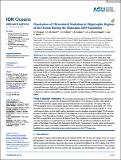Por favor, use este identificador para citar o enlazar a este item:
http://hdl.handle.net/10261/272301COMPARTIR / EXPORTAR:
 SHARE SHARE
 CORE
BASE CORE
BASE
|
|
| Visualizar otros formatos: MARC | Dublin Core | RDF | ORE | MODS | METS | DIDL | DATACITE | |

| Título: | Penetration of Ultraviolet-B Radiation in Oligotrophic Regions of the Oceans During the Malaspina 2010 Expedition |
Autor: | Overmans, S.; Duarte, Carlos M. CSIC ORCID; Sobrino, Cristina CSIC ORCID; Iuculano, Francesca CSIC ORCID; Álvarez-Salgado, Xosé Antón CSIC ORCID ; Agustí, Susana CSIC ORCID | Fecha de publicación: | may-2022 | Editor: | American Geophysical Union John Wiley & Sons |
Citación: | Journal of Geophysical Research - Part C - Oceans 127(5): e2021JC017654 (2022) | Resumen: | Few studies have investigated ultraviolet (UV) radiation in the open ocean besides its harmful effects on organisms and influence on biogeochemical processes. Here, we assessed UV attenuation, with particular focus on UV-B, across the (sub)tropical ocean during the Malaspina 2010 Circumnavigation. Vertical UV radiometer profiles together with Chl-a concentration, and UV absorption by CDOM (aCDOM(λ)) and by suspended particulate matter (ap(λ)) were measured at 117 stations. At photosynthetically active radiation (PAR) and across UV-A and UV-B wavelengths, the lowest downwelling attenuation coefficients (Kd) during the expedition were recorded in ultra-oligotrophic regions at 5°–15°S (mean Kd(305 nm): 0.129 m−1, mean Kd(313 nm): 0.107 m−1) in the Indian and South Pacific Oceans. The waters here were comparatively more transparent than at 5°–15°N (mean Kd(305 nm): 0.239 m−1, mean Kd(313 nm): 0.181 m−1) where equatorial upwelling occurs. Kd was highest near the Costa Rica Dome (Kd(313 nm): 0.226 m−1) and at the confluence of the Benguela and Agulhas currents (Kd(313 nm): 0.251 m−1). The contribution of ap(λ) toward nonwater absorption (anw(λ)) was significantly lower at 305 nm than at 313 and 320 nm, suggesting the contribution of absorption by detritus and phytoplankton particles decreases compared with that of CDOM absorption as UV-B wavelength decreases. Both aCDOM(λ) and ap(λ) at UV-B wavelengths were lowest in the Indian Ocean whereas Kd was lowest in the South Pacific. This finding emphasizes that other factors besides absorption, such as scattering by reflective phytoplankton or inorganic particles, strongly influence UV-B attenuation in open ocean waters | Descripción: | 21 pages, 4 tables, 8 figures.-- This is an open access article under the terms of the Creative Commons Attribution-NonCommercial-NoDerivs License | Versión del editor: | https://doi.org/10.1029/2021JC017654 | URI: | http://hdl.handle.net/10261/272301 | DOI: | 10.1029/2021JC017654 | E-ISSN: | 2169-9291 |
| Aparece en las colecciones: | (IIM) Artículos (IMEDEA) Artículos |
Ficheros en este ítem:
| Fichero | Descripción | Tamaño | Formato | |
|---|---|---|---|---|
| Penetration_ultraviolet_OA_2022.pdf | 2,05 MB | Adobe PDF |  Visualizar/Abrir |
CORE Recommender
SCOPUSTM
Citations
3
checked on 20-abr-2024
WEB OF SCIENCETM
Citations
3
checked on 27-feb-2024
Page view(s)
89
checked on 26-abr-2024
Download(s)
67
checked on 26-abr-2024
Google ScholarTM
Check
Altmetric
Altmetric
Este item está licenciado bajo una Licencia Creative Commons

